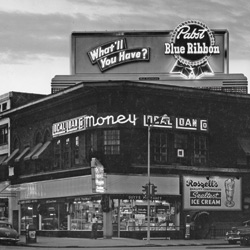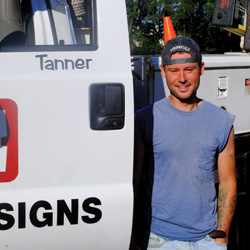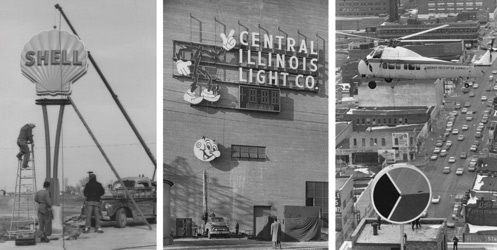For three generations, the Hardin family has been working together to create quality industrial signs.
For Bill Hardin, life is more about show than tell. Rather than explaining how Hardin Signs creates six-foot tall letters, he takes you on an all-inclusive tour of the workshop. Instead of describing the pivotal elements of his portraits, he gathers examples and points them out. This hands-on approach translates well into his work as both an artist and for the family-owned Hardin Signs.
And Hardin’s family is a critical element in both of his callings. Growing up, he found inspiration in paintings by his parents and sister. He went on to learn about mechanical drawing from his father and start Hardin Signs with his wife. Today, he works with both his son and his grandson.
 The Art of Sign Making
The Art of Sign Making
In 1948, as a junior at Bradley University, Bill Hardin got his career off the ground at Foster Electric (now Foster-Jacob), before putting his skills to work at Roesch Electric. Twenty years later, with a few decades of experience under his belt, Hardin believed himself well-equipped to start his own business. “I had that experience,” he affirms, “and that gave me the guts to go out on my own.”
And so, in 1967, he founded Hardin Signs with his wife, Marian. A year later, their son, Jim, started working for the company on his summer breaks from high school, before going to work full time after graduating from Bradley in 1973.
The trio has seen Hardin Signs through many changes. Hardin recalls the days when they didn’t use cranes or electric power, but employed manual hand cranks and pulleys to position signs atop multi-story buildings. As with nearly every industry, he attests that the most significant change over the years has been the introduction of the computer. Processes that once took many hours to accomplish by hand now require a mere 15 minutes. “I can take a picture of a building, then come back and computerize it,” he explains. “I can design a sign, stick it on the building, superimpose it, and it looks like it’s been there forever.”
Beyond the influence of the computer, LED lights were a leap forward for the sign industry. Short for “light-emitting diodes,” LEDs are small, bright lights that use only about 12 volts of energy. They are especially ideal during the winter, Hardin says, because they continually put out 100-percent light and are virtually unbreakable. They also consume just a tenth of the amount of power as neon.
The unpredictability of sign making is one of Hardin’s favorite aspects of the job. “During the war, aluminum wasn’t available,” he recounts. “Everything was stainless steel. Things progressed through the years, and LEDs came along. We just keep up with the pace of things. That’s what makes it fascinating—it’s always changing.”
 Challenge & Opportunity
Challenge & Opportunity
Weathering these changes alongside Bill and Jim Hardin is Jim’s son, Tanner, and a team of about 16 people, including an office staff and members of three trade unions: sheet metal workers, electricians and painters. From designing the signs to building and installing them, Hardin Signs handles just about everything.
“We have a very quality-oriented and loyal group of employees, and we have had a good working relationship all these years with all the people working with us,” Jim says. “That is something we can offer to our customers—consistency and quality. That’s what we strive to maintain.”
But with progress comes challenges, and Hardin says the most difficult one came just 15 months into his ownership of the business. Dealing with the death of his father-in-law, building a new house, and moving his mother-in-law in to live with him and his family, he already had a full plate. Then, Hardin Signs’ building on Sheridan Road burned to the ground, leaving just a few salvaged Caterpillar signs remaining. The business temporarily moved to East Peoria until an opportunity to return to Peoria presented itself.
Having just purchased the property that once belonged to Meadowbrook Dairy, Abie Cohen, a friend of Hardin’s, had one piece of unclaimed land left over in the deal. He offered it to Hardin, who leapt at the opportunity. Hardin Signs set up shop on North Meadowbrook Road, “and we’ve been here ever since,” he says with a smile.
 Picture Perfect
Picture Perfect
With the business at its new location and settling into its niche in the Peoria area, Hardin began to focus on his other passion: painting portraits. Though Hardin says that sign-making is the ideal job for him, he adds, “I get the real pleasure by doing the portrait work.” And while industrial signs and intricate portraits may seem dissimilar to some, Hardin reveals the connection.
“Everything is related to art,” Hardin begins. “There is art involved in everything we do—everything we see, every building, every car, every dress you wear. Everything that we do is in some way tied to art.”
Hardin’s portrait career took off after his first published work in 1977. The commission was used to fund a trip to New York City, where he studied portraiture under the celebrated painter, John Howard Sanden. “That was the best learning experience I have ever had in my life,” Hardin says of his time with Sanden.
Putting his training to good use, Hardin has painted portraits of many renowned Peorians over the years, from Pete Vonachen and Anne Fox to Murray Baker and Dan Fogelberg, as well as national figures from Abraham Lincoln to Sarah Palin. He creates his masterpieces in Door County, Wisconsin, in a house that he and his wife have owned for nearly three decades. Often staying up until three or four in the morning working on a painting, he admits, “I work until I get it perfect.”
Those long nights pay off when he presents the portrait to its recipient. “Just to see the people and their reactions to my paintings when they are done is so gratifying to me,” he says.
Third Time’s the Charm
For all of Bill Hardin’s accomplishments, in business and in art, he never claims them solely as his own, citing various members of his family as the determining factor in his success. He explains the significant role of his parents and sister, recalling the days he would sneak up to the attic to steal a glance at his sister’s artwork.
Hardin’s introduction into the business world came from his father, a teacher at Manual High School. “He taught mechanical drawing, and I took every course he had,” he recalls fondly. “He was the best teacher I ever had—he really was.” He also credits Marian for her support and work as the financial guru and bookkeeper when Hardin Signs first opened its doors.
And that support has been passed down through the generations. As vice president of Hardin Signs, Jim Hardin has taken over many of the pressures associated with owning the business, including coordinating all the work in the shop and the office, selling signs, ordering materials, setting production schedules, and performing administrative duties. He explains that his role at Hardin Signs has increased as his dad has gotten older, but he was fully prepared for the increased workload.
“I have enjoyed working with my dad and have learned a lot from him,” says Jim, adding, “The other benefit is I have my son working here, too. He is one of the lead installers, and I am very proud of him.”
Jim’s son, Tanner, began his own career at Hardin Signs 12 years ago, after graduating from a sheet metal trade school. He installs signs and handles the more hands-on aspects of the business. “[Tanner] is such a go-getter, so reliable, so sure of what he’s doing,” describes his proud grandfather. With a twinkle in his eye, Hardin adds, “It’s so rewarding for me to see my son and grandson want to be here and work with me. That is the most gratifying of all.” iBi


